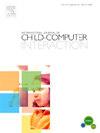Investigating children ’s multimodal enactment in Digitally Augmented Tabletop storytelling
Q1 Social Sciences
International Journal of Child-Computer Interaction
Pub Date : 2025-09-02
DOI:10.1016/j.ijcci.2025.100770
引用次数: 0
Abstract
Young children often struggle to effectively express their ideas in both speaking and writing due to their developing cognitive and linguistic abilities. To address this challenge, this paper introduces the Digitally Augmented Tabletop Enactment (DATE) approach that integrates tactile-kinesthetic, augmented visual, and auditory elements to support motivation and multimodal enactment in storytelling by enriching children’s interactive experiences and fostering dynamic information processing across multiple sensory modalities. To implement this approach, we developed the lightweight Tabletop Imaginative Play as Enactive Storytelling (TIPES) system that combines physical play on a tabletop with real-time digital story representation. This system captures children’s manipulation of figurines and translates their actions into animated scenes, empowering them with direct control over story content and instant visual feedback.
We conducted a user study with 36 children to evaluate our approach’s impact compared to traditional tabletop storytelling. Our analyses examined the children’s embodied interactions during story enactment, writing performance, and user feedback. Results revealed that the DATE approach supported a stronger integration of physical and vocal modalities, greater narrative agency, and strengthened eye–hand coordination, reflecting deeper engagement. Importantly, children’s performance in verbal tasks such as speech narration and writing remained comparable across conditions, indicating that multimodal enactment along with an additional digital authoring experience can enrich storytelling without compromising narrative output quality. Additionally, children expressed strong enthusiasm for the DATE approach, underscoring its appeal in sustained engagement in creative storytelling. These findings highlight the potential of physical–digital tabletop enactment as a promising direction for designing educational technologies that scaffold expressive, collaborative, and developmentally appropriate narrative practices.
调查儿童在数字增强桌面故事叙述中的多模式行为
由于幼儿认知和语言能力的发展,他们往往很难有效地表达自己的想法。为了应对这一挑战,本文介绍了数字增强桌面模拟(DATE)方法,该方法集成了触觉-动觉、增强视觉和听觉元素,通过丰富儿童的互动体验和促进跨多种感官模式的动态信息处理,支持讲故事的动机和多模态模拟。为了实现这一方法,我们开发了轻量级的桌面想象游戏作为动态故事叙述(TIPES)系统,该系统将桌面的物理游戏与实时数字故事表示相结合。该系统捕捉儿童对小雕像的操作,并将他们的动作转化为动画场景,使他们能够直接控制故事内容和即时视觉反馈。我们对36名儿童进行了一项用户研究,以评估我们的方法与传统桌面讲故事的影响。我们的分析考察了孩子们在故事设定、写作表现和用户反馈过程中的具体互动。结果显示,DATE方法支持身体和声音模式的更强整合,更强的叙事代理,并加强眼手协调,反映出更深层次的参与。重要的是,儿童在口头任务(如演讲叙述和写作)中的表现在不同条件下保持可比性,这表明多模式制定以及额外的数字创作经验可以在不影响叙事输出质量的情况下丰富讲故事。此外,孩子们对DATE方法表达了强烈的热情,强调了它在持续参与创造性讲故事方面的吸引力。这些发现强调了物理-数字桌面模拟的潜力,它是设计教育技术的一个有希望的方向,可以支撑表达性、协作性和发展适宜的叙事实践。
本文章由计算机程序翻译,如有差异,请以英文原文为准。
求助全文
约1分钟内获得全文
求助全文
来源期刊

International Journal of Child-Computer Interaction
Social Sciences-Education
CiteScore
7.20
自引率
0.00%
发文量
73
 求助内容:
求助内容: 应助结果提醒方式:
应助结果提醒方式:


